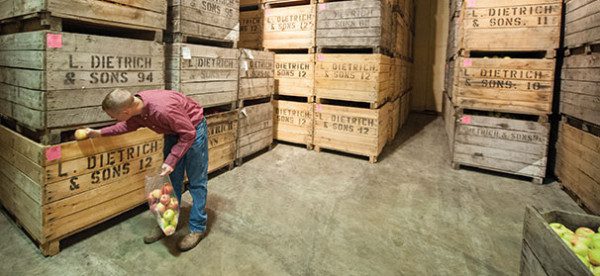

Jul 3, 2014Researcher aims to preserve apple aroma in storage
With a bumper crop of apples in 2013 – coming off one of the worst growing seasons in more than 50 years in 2012 – Michigan producers were concerned about storing the crop in a manner that would not compromise the fruit’s firmness, flavor or aroma.
Michigan State University (MSU) horticulture professor Randy Beaudry has discovered a genetic pathway that plays an important role in producing apple aroma profiles, a key quality that helps Michigan apples remain competitive in national and international markets.
“One of the most important characteristics of the food we eat is its flavor, which is composed of taste and aroma,” wrote Beaudry, in a report included in MSU AgBioResearch’s 2013 annual report. “In addition to the research I do to preserve the postharvest quality of fruits and vegetables, I also work on the chemistry and biochemistry of food quality.”
For more than half a century, MSU researchers have refined the controlled-atmosphere (CA) process of apple storage. Beaudry has been at the forefront, working to perfect the technique. The storage method suspends the ripening process by regulating the amount of oxygen, carbon dioxide and nitrogen. The temperature and humidity of the storage areas are also controlled.
The storage technique also suspends the fruit’s ability to synthesize esters, fragrant organic compounds that contribute to the apple’s unique aroma. Beaudry explained that, though CA storage is very effective at helping the fruit remain firm, this secondary, unintended consequence could diminish aroma quality over time.
“The apples don’t taste bad, but they can lack the rich flavor of fully developed apples,” Beaudry said. “Fruits change their aroma profiles in well-prescribed proportions, but a large number of things that humans do to fruits also alter them. Some of my early work documented the effect of CA and other storage treatments on aroma, and we found it takes time for apples to recover their ability to produce aroma compounds once they’re removed from storage.”
According to the report, Beaudry’s goal is to provide consumers with fruit that is firm and full-flavored.
“It would be wonderful to specifically trigger aroma formation without triggering softening,” he explained. “This isn’t the No. 1 priority of the apple industry, but in terms of its long-term vision, my research in this area will have some value.”
Desiring a better understanding of how apples synthesize their aroma-producing esters, Beaudry began to search for genes that were expressed at the same time that apples synthesize ester compounds. Of the 10,000 genes he observed, one possessed characteristics implicated in ester biosynthesis.
“As we looked more into this oddball gene, we realized that its annotation, which is based on previous research, indicated that it would make apples smell like bananas – but it doesn’t,” he said. “It turned out that the gene was, in part, annotated incorrectly and was actually part of a more substantial gene family.”
Further exploration of this gene – along with a series of experiments that involved dissecting bacterial pathways, studying stable isotopes, isolating genomic DNA, expressing the gene in a bacterial system and determining the function of certain proteins – led to the identification of a previously undiscovered plant pathway: the citramalate pathway, which contributes to the formation of branched-chain acids and branched-chain esters.
“We were looking at something others probably would have told us was not a fertile area of investigation, but we were able to discover an entirely new biology in the specialized tissue of an apple fruit,” he said. “We identified a new pathway that, for some apple fruits, is relatively important.
“Even scientists who spend a lot of time on applied research have to stay current in their science,” Beaudry concluded. “If we don’t, we fall behind. You have to have applied science to recognize the problems for what they are and, when possible, take them to the fundamental level and try to build some new science.
“The apple industry is happy with the storage problems I am addressing, but they also know that flavor is important for the resale value of apples – especially apples that have been stored for a long period. With that in mind, the discovery of this pathway certainly fits into the long-term objectives of that group.”














